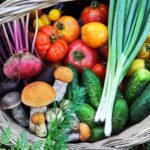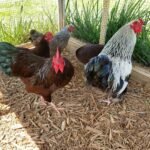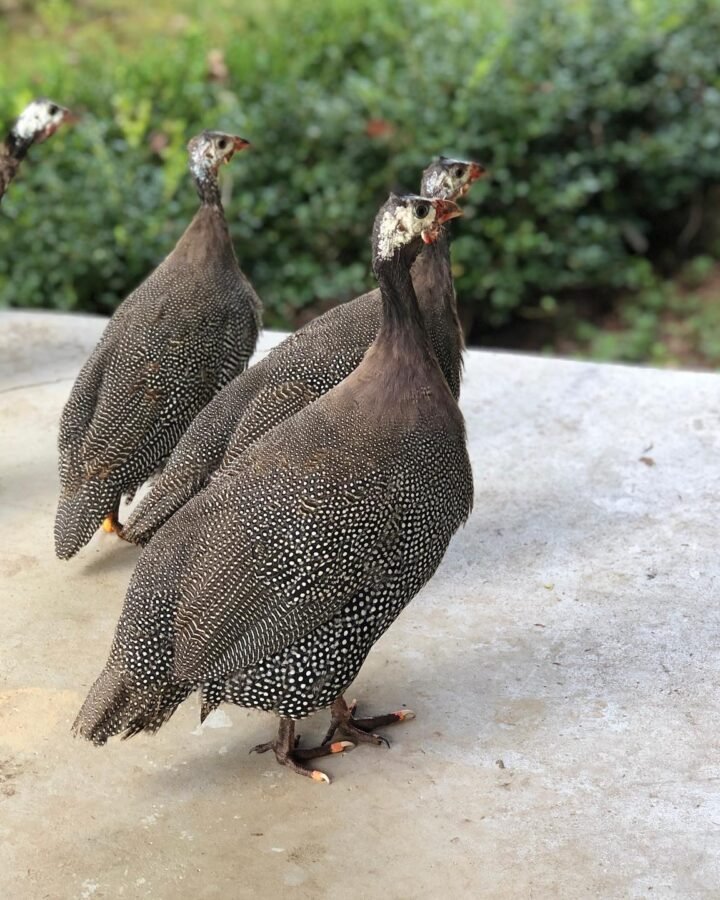Do you know that mallard ducks and wild turkeys are also game birds?
But here, I only talk about the most typical and profitable gamebirds known for their yield.
Known for their sports purpose, gamebirds also make good table birds and give plenty of eggs for recipes or hatching new birds.
So, here is the list of the best game birds to raise at homesteads and farms.
1. Pheasants
Pheasants are beautiful, large, and long-tailed game birds.
They can weigh 2 – 3 lbs and live for a year. Famous for sports, pheasants are bred for hunting and training dogs.
Besides, their meat is also famous for non-veg recipes and is sold in supermarkets. The whole bird is excellent for roasting, casseroling, or as breast fillets for quick cooking.
Around 70 percent of meat comes only from the breast, but you should enjoy gnawing on a bone.
While their breast are white, their legs and thighs look dark.
Do you know that pheasant feathers are in high demand?
Yes, their vibrant and colorful feathers are used in fly fishing lures and other decorative items. They also make your homestead or farm vibrant with their enticing appearance, making it a bird exhibition.
What I like about them is that the birds reproduce faster. They are seasonal layers that can yield 15-20 eggs per clutch and hatch 2-3 times yearly.
Their eggs range from light to dark brown.

You can raise pheasant chicks in the brooder and transfer them to flight pens or grow-out pens when they are 5 – 8 weeks old.
They also do well in the free range system or in a mini forest-like setting.
Remember, they are vulnerable to nest predators such as foxes and corvids. So, you need to consider these before raising pheasants.
Also, these game birds need large enclosures and controlled breeding to prevent aggression.
Meat Quality: White and dark, lean, dry, and flavorful
Egg Production: 40 – 60 dark brown, light brown, olive, and blue eggs
Best Breeds: Ring-necked pheasant, Golden pheasant, Red Golden pheasant
2. Quail
These tiny-looking birds are great for laying eggs. Can you imagine, they can produce the yield of more than 300 eggs every year?
You can expect them to lay daily, even in winter.
Quail are also faster to grow and mature within 35 days. But that depends on what breeds of quails you keep.
They start laying eggs anywhere between 6 and 12 weeks. So, it’s worth investing for temporary and small homestead or farm owners who want to get quick yields and profits.
As gamebirds, quails have so much to offer. They make excellent and sustainable sports birds for hunting and training your German shepherds.
Though small, their meat is dark, juicy, flavorful, and popularly in demand for restaurant recipes at a premium price.
You can eat or sell their eggs for profit or hatch them in incubators for the large population. You can also encourage quails to lay more eggs naturally.
These birds are compact and small, so they don’t make a fuss when kept in the coop or cage. They can also do well in chicken coops and rabbit hutches.

But you need to make sure the height of the confinement is high enough so that the birds do not hurt themselves when trying to fly.
They fly so hard that they can hit the roof easily.
So, if you have a large number of quails, I suggest you invest in the flight pen or aviary system.
They have fewer sleeping hours, so you need to provide them with extended periods of artificial lighting after daylight.
Meat Quality: Lean, tender, dark, and juicy
Egg Production: 200 -300 white, blue, green, brown, or speckled eggs or more than 300 eggs per year
Best Breeds: Coturnix quail (for eggs and meat), Bobwhite quail (for game), Texas A and M quail
3. Guinea Fowl
Guinea Fowls are turkey or chicken-like gamebirds that have featherless, bald, or helmet-like heads.
You can tell these birds by their dark grey bodies with white dots or speckles and short-pointed tails. They are also larger than a standard-sized chicken and have compact and pumped bodies with tight feathering.
These fowls weigh 3 – 5 lbs and give around 100 thick-layered eggs per season.
Their meat and eggs are popularly growing in the niche market, especially in organic and gourmet markets.
Unlike chickens, they are more independent and great foragers that pasture all day for food, which can save food costs for owners.
They eat grass, seeds or grains, and insects. Bugs, slugs, worms, and small rodents are their favorite prey, which helps the fowls to control pests in the backyard.
Don’t worry, they won’t harm or destroy your garden.
But Guinea fowls don’t like to be confined, so you need to be generous to provide them with living space. They need a large free-range system.
Many small homestead and farm owners don’t prefer keeping them.
It doesn’t mean that birds aren’t worth raising. Guinea fowls have several benefits, including making flock guardians for other poultry birds and farm animals. They make no trouble with others. All they want is carefree forage and nesting.
These gamebirds roost in trees or poles and nest anywhere they feel. So, hunting Guinea Fowl nests can be a creative pastime for your kids.

They can tolerate heat well but are not very fond of snow.
So, it’s the owner’s duty to arrange a runner that can save birds from rain, cold, snow, sun, and predators.
As they are vocal or noisy, they immediately warn against nearby predators. This can be troublesome for you and your neighbors if you raise Guineas in a residential area.
However, it is easy to raise guinea fowls as they are friendly, docile, and affectionate like chickens.
Meat Quality: Darker, slightly gamey, and rich in flavor
Egg Production: 100-125 light brown, speckled eggs per year
Best Breeds: Pearl guinea, White guinea, Lavender guinea
4. Partridges
Patridges are medium-sized game birds, larger than quails and smaller than pheasants.
They are ground-dwelling birds but can fly, so you may need an aviary environment to keep them.
The birds appreciate the pen’s hiding places, which include brush, shrubs, small trees, and grasses. Modern homesteaders raise them in the backyard and atop their houses.
You can also raise them in a free-range environment.
But ensure your birds have enough space and ventilation in the confinement. If not, they start cannibalizing each other, and the whole flock is at risk of extinction.
They weigh around 12–21 oz, producing a bit more meat than that of quails.
You can have your first harvest or gameplay when your partridges are between 16 and 18 weeks. The birds are versatile in the culinary arts, from roasting to cooking.
Keepers can expect these gamebirds to lay between April and June.

Patridges are slightly more delicate than quail, so you need to make an effort for their feed and care. If the birds receive good care, they can live from 3 to 5 years.
Meat Quality: Darker, more intense flavor
Egg Production: 40-60 white-shelled eggs per year
Best Breeds: Red-legged partridge, Grey partridge, Chukar partridge
5. Peafowl
Peafowls are large game birds that make excellent show birds. Their beautiful feathers are also used for various ornamental purposes, including crafts and home decor.
You can even sell the fallen feathers for profit.
Collecting their plumage is one of my favorite pastimes at my homestead!
These birds shed their feathers during their annual molt in summer and regrow them by late winter. The catch is that they don’t grow their tail until they are three years old.
Peafowls are slow to mature, so keepers need to have enough patience in rearing birds.
You can expect them to live for at least 12-15 years. Your homestead or farm would lighten up with their presence. Have you watched a peacock stretching its tail?
But they require a spacious living area to shelter, forage, dance, and breed. In the lack of a large space, you can find the birds standing or sitting on cars and perching on porch railings and house roofs.
They also deposite their large poop everywhere they go.
Also, the birds can invade the garden and destroy the produce. They are strong flyers, so even the tall fences cannot restrict them.
The good news is that peafowls are curious and friendly, so you need to train them and manage them to their correct place.

These gamebirds are also natural pest controllers that happily forage for all kinds of bugs around the farm. In fact, they are omnivores that eat insects, grass, flowers, seeds, and small mammals.
They are known for gulping mice and snakes, which can help remove a few chicken predators in the backyard.
Many keepers raise these birds for special festivals, especially for gaming purposes.
They weigh 6 – 13 lbs, making big table birds.
Besides, peahens lay a clutch of 4 – 12 eggs per season. If you pick up eggs when hens sit on them, they will consistently lay and accumulate 3 clutches in a year.
Meat Quality: Exotic, lean, and rich in flavor
Egg Production: 10 – 30 large light brown eggs with darker spots eggs
Best Breeds: Indian Peafowl, Green Peafowl, White Peafowl
Final Thoughts
Game birds have a wild living instinct, so the larger they are, the more freedom they need.
So, space and birds’ growth rate are the influencing factors while choosing the suitable game birds to raise at your place.










Leave a Reply